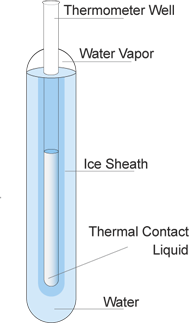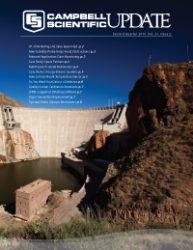Our slogan here at Campbell Scientific is, "When measurements matter." Making good measurements has been important to us from the beginning. Calibration is an important part of ensuring accurate measurements. To calibrate any piece of equipment, a standard with known accuracy must be used for comparison. Most calibration standards that we use have traceability to the National Institute of Standards and Technology (NIST). The NIST traceability of these standards is essential to ensure the validity of the measurements and comparisons made, and to ensure that the accuracy is within acceptable limits.
In some cases a physical standard can be used for calibration as long as it exhibits a natural characteristic that is constant and repeatable. One such standard is the triple point of water—the temperature (0.010°C) at which water can exist as a solid, liquid, and gas. Using a triple-point-of-water cell, the three phases can be realized and the physical standard can then be used for calibration, with an accuracy of ±0.0001°C.
For example, we use the triple point of water for calibrating our 105E thermocouples. It serves two very useful purposes for this. First, it gives us a known temperature (0.010°C) that we can create for the reference junction of the thermocouple using our triple-point cell. Second, we use it to validate our platinum resistance thermometer (PRT) that we use on the measurement junctions of the 105E thermocouples during calibration.
Our triple-point cell and PRT are just two of the instruments we have at Campbell Scientific to ensure that our products meet your needs. Whether we calibrate our products to an NIST-traceable standard or to a reliable physical standard, we are conscientious about the measurement accuracy of our products and are dedicated to maintaining a high degree of overall measurement quality.
| A triple-point cell: The triple point of water (0.010°C), at which water exists in solid, liquid, and gas form at the same time, is used to calibrate thermometers and thermocouples. |  |

